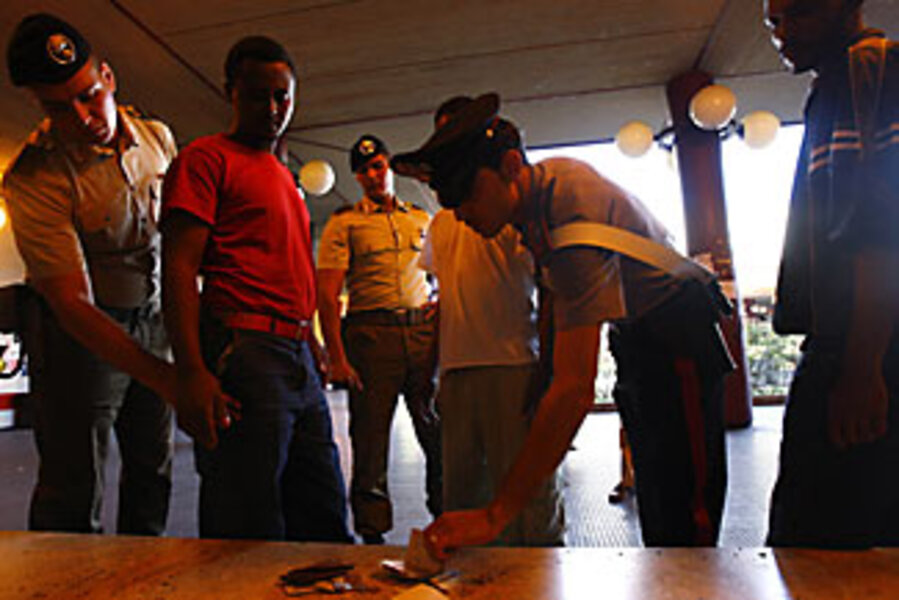Spain, Italy: Two tactics for tackling illegal immigration
Loading...
| MADRID; and milan, Italy
Miriana spends her nights sleeping in a park, and her days hunched on a stoop outside a Madrid shop, begging for money. The young woman admits that she earned more in Italy, where she lived for a year. But for this Romanian immigrant, who is also ethnically Roma (or gypsy), the decision to move to Spain was easy.
"Here, the people are better," she explains in broken Spanish. "They don't have as much hate."
Both Spain and Italy, situated across from Africa on the Mediterranean coast, have faced huge influxes of illegal immigrants over the past couple of years – 18,000 intercepted by Spain last year alone, and 12,000 by Italy so far this year. But their governments, though sharing a conviction that the problem urgently needs to be curbed, have taken different approaches to reach that common goal.
While Spain struggles to find the balance between limiting immigration and protecting human rights, Italy has implemented state of emergency measures and even fingerprinting of Roma – measures decried as "xenophobic" by the human rights commissioner for the Council of Europe, Thomas Hammarberg.
"The Spanish government has a very strict policy," says Roberto Malini, president of the Italian human rights organization EveryOne. "The Italians have an intimidatory policy: the idea is to scare immigrants, so that when they go home, they can tell their countrymen that Italy is no place for foreigners."
Italy: State of emergency
On July 25, Italian Prime Minister Silvio Berlusconi's government passed a decree that allows the government to use military troops to monitor the country's 16 immigrant internment centers and to deploy another 3,000 soldiers to several cities in an effort to control crime, which is often blamed on immigrants.
Parliament also recently passed a law specifying that illegal immigrants convicted of crimes can be held for up to a third longer than Italians convicted of the same felony. Property rented to illegal immigrants can be confiscated under the new legislation.
These steps have troubled human rights activists. "At the identification centers used to hold North Africans, immigrants often face violence and intimidation," says Mr. Malini. "But they're not in a position to complain, because they'll be expelled."
Italy's measures have hit the Roma most severely. Though some have lived in Italy for years, many came from Romania when that country joined the European Union in 2007. Berlusconi's predecessor, former Prime Minister Romano Prodi, had ordered some deportations of Roma, despite their EU citizenship. Under Mr. Berlusconi, Italy has gone further, initiating a census of Roma that began in June and included fingerprinting.
This discrimination has been fed by media headlines such as "Invasion of the Nomads." And it has trickled down in other ways as well. In July, the rightwing Northern League party presented a proposal in one region that would ban "kebab shops" and Chinese restaurants from city centers because they were "incompatible with the historical context." Vigilante groups in southern Italy have set fire to Roma enclaves and attacked their inhabitants.
Spain: Balancing rights, crackdown
In Spain, where legal immigrants alone make up nearly 9 percent of the population, Prime Minister José Luis Rodríguez Zapatero surprised many at the start of his second term this spring by directing an about-face of his administration's previously lenient immigration policies.
In June, just three years after authorizing a mass legalization of 750,000 undocumented workers, Mr. Zapatero expressed support for the EU's Return Directive – a policy that allows member states to hold undocumented migrants, including minors, for up to 18 months, and, if deported, bans them from returning.
Faced with a 10.7 percent unemployment rate, Zapatero's new labor minister has announced a plan that would pay jobless immigrants to return to their home countries. The Catalan regional government, among the most progressive in Spain, has authorized a program that would temporarily segregate newly arrived immigrant children from non-European countries in special schools designed to better prepare them for integration into the regular educational system. The government is expending greater resources on preventing migrant-laden boats from reaching Spanish shores, and more frequently deporting those who do land.
Zapatero's immigration policy has been criticized by immigrants-rights organizations. Antonio Abad, secretary-general of the Spanish Commission for Aid to Refugees (CEAR), points out, for example, that by increasing the monitoring of the Moroccan and Mauritanian coasts, Spanish authorities have compelled sub-Saharan migrants to begin their sea journey from points farther south, endangering themselves even further. "It takes the people who need the most protection and makes things even harder for them," he says. He also criticizes Zapatero's support for the Return Directive. "When you limit one person's rights, you limit all of society," he adds.
Yet Zapatero has balanced these more rigid policies with other kinds of efforts. He appointed the first immigrant to his cabinet in April and has promised to extend the vote to legal immigrants by the end of this term. Those efforts, say Abad, make a difference. "On the positive side, we can see that the government has a strategy for integration.... It's totally different from the racist measures you see in Italy."





